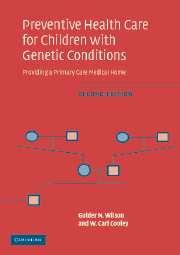Book contents
- Frontmatter
- Contents
- Preface
- Glossary of genetic and molecular terms
- Part I Approach to the child with special needs
- Part II The management of selected single congenital anomalies and associations
- Part III Chromosomal syndromes
- Part IV Syndromes remarkable for altered growth
- Part V Management of craniofacial syndromes
- Part VI Management of connective tissue and integumentary syndromes
- 16 Connective tissue disorders
- 17 Integumentary syndromes
- Part VII The management of neurologic and neurodegenerative syndromes
- Part VIII Management of neurodegenerative metabolic disorders
- References
- Index
16 - Connective tissue disorders
Published online by Cambridge University Press: 29 January 2010
- Frontmatter
- Contents
- Preface
- Glossary of genetic and molecular terms
- Part I Approach to the child with special needs
- Part II The management of selected single congenital anomalies and associations
- Part III Chromosomal syndromes
- Part IV Syndromes remarkable for altered growth
- Part V Management of craniofacial syndromes
- Part VI Management of connective tissue and integumentary syndromes
- 16 Connective tissue disorders
- 17 Integumentary syndromes
- Part VII The management of neurologic and neurodegenerative syndromes
- Part VIII Management of neurodegenerative metabolic disorders
- References
- Index
Summary
Children with connective tissue weakness and increased joint laxity are at increased risk for a variety of medical problems (Jones, 1997, pp. 472–94; Adib et al., 2005). General manifestations can include increased range of motion and the ability to perform “double-jointed” maneuvers; altered skeletal proportions with elongation of the craniofacies, thorax, and limbs; susceptibility of joints and internal organs to damage during normal function (e.g., joint dislocations, hernias, optic lens dislocations, mitral valve prolapse), and skin fragility manifest by increased bruising, unusual scarring, and stretch marks. Particular syndrome phenotypes depend on the component of connective tissue that is altered and the spectrum of other developmental abnormalities (Table 16.1).Connective tissue dysplasia is a common feature of many different syndromes, but is the primary clinical manifestation for the syndromes discussed in this chapter. The Marfan and Ehlers–Danlos syndromes are prime examples of connective tissue dysplasias, and detailed discussions with checklists are provided. Syndromes with the opposite finding – tight connective tissue that leads to contractures (arthrogryposis) – will be discussed in Chapter 18.
Inspection of Table 16.1 reveals general features of connective tissue dysplasia that can be part of a generalized condition like Down syndrome or homocystinuria or be of primary concern as in the Marfan or Ehlers–Danlos syndromes. The elongated cranium causes a high palate, resulting in tooth crowding and dental problems. Decreased scleral tissue may allow underlying choroid to show through and produce blue/grey sclerae, and increased deformability of the eye or lens can produce myopia with lens trembling or slippage.
- Type
- Chapter
- Information
- Preventive Health Care for Children with Genetic ConditionsProviding a Primary Care Medical Home, pp. 413 - 436Publisher: Cambridge University PressPrint publication year: 2006



